A Note About Images: The images used in our articles are for illustration purposes only and may not exactly match the content. They are meant to engage readers, but the text should be relied upon for accurate information.
Welcome to the insightful journey of exploring the intricate process of gentrification. Gentrification, a phenomenon reshaping cities globally, is a multifaceted and thought-provoking transformation that impacts communities in profound ways. It involves the revitalization of neglected neighborhoods, often resulting in economic development and urban renewal. However, this process is not without its challenges and controversies. In this article, we will delve into eight astonishing facts about gentrification, shedding light on its impact, causes, and consequences. Whether you are a resident of a gentrifying neighborhood, a policymaker, or someone curious about the dynamics of urban landscapes, this article will provide you with a deeper understanding of this complex issue.
Unveiling the Facets of Gentrification:
1. Gentrification: The Urban Revitalization Process
Gentrification refers to the transformation and redevelopment of urban areas, characterized by an influx of wealthier residents and businesses into previously low-income neighborhoods. This process often brings about changes in the physical landscape and socio-economic dynamics of a community.
2. Displacement of Lower-Income Residents
As neighborhoods undergo gentrification, the cost of living typically rises, making it challenging for long-time residents with lower incomes to afford the increasing rents and property prices. This can lead to the displacement of communities that have called these areas home for generations.
3. Cultural Shifts in Neighborhoods
The influx of new businesses and residents into gentrified neighborhoods can result in significant cultural changes. Traditional establishments and community spaces may be replaced by trendy cafes, boutiques, and upscale restaurants, altering the fabric of the local culture.
4. Global Reach of Gentrification
Gentrification is not confined to specific cities or countries; it is a global phenomenon observed in major urban centers worldwide. From London to New York City, the effects of gentrification are felt across diverse cultural settings.
5. Impact on Property Values
One of the outcomes of gentrification is the increase in property values as investments and improvements are made in the neighborhood. While this may benefit homeowners, it can also lead to higher property taxes and affordability challenges for lower-income residents.
6. Infrastructure and Amenities Enhancement
Amid gentrification, local governments and developers often invest in improving infrastructure such as roads, parks, and public transportation to attract more residents and businesses to the area. This can contribute to the overall development of the neighborhood.
7. Tensions Between New and Existing Residents
The arrival of wealthier residents and businesses in gentrifying neighborhoods can create tensions with existing community members. Cultural differences, affordability issues, and concerns about preserving the neighborhood’s character are common sources of conflict.
8. Mixed Economic Impacts
While gentrification can stimulate economic growth and boost tax revenues for local governments, it can also lead to the displacement of long-time residents and the closure of small, locally-owned businesses that struggle to compete in the changing landscape.
In Conclusion:
Gentrification is a complex and nuanced process with significant impacts on communities. By understanding the facts surrounding gentrification, we can engage in informed discussions about its consequences and potential solutions. From the displacement of residents to the transformation of neighborhoods, gentrification reshapes the urban environment. It is imperative for policymakers, city planners, and communities to collaborate in addressing the negative effects of gentrification and promoting inclusive development.
Frequently Asked Questions:
What is gentrification?
Gentrification is the redevelopment and revitalization of low-income or neglected areas, often leading to an influx of wealthier residents and businesses.
What causes gentrification?
Gentrification can be triggered by factors such as increased demand for urban living, rising property values, and government policies encouraging redevelopment.
Why is gentrification controversial?
Gentrification sparks controversy due to its potential to displace long-time residents, erase affordable housing options, and impact community culture and history.
Can gentrification benefit the community?
While gentrification can bring positive changes in terms of infrastructure and economic growth, it can also exclude marginalized communities and deepen socio-economic disparities.
How can negative effects of gentrification be mitigated?
Potential solutions include implementing affordable housing policies, establishing community land trusts, and ensuring community involvement in urban development decisions.
Can gentrification be reversed?
While challenging to reverse completely, targeted policies and community-driven initiatives can foster more inclusive and equitable neighborhoods.
How does gentrification affect small businesses?
Gentrification can displace small businesses due to rent increases and shifts in the consumer base, impacting the local economy and cultural diversity.
What role does community engagement play in addressing gentrification?
Community engagement is crucial in addressing gentrification as it ensures residents’ voices are heard, fostering collaboration in shaping the future of neighborhoods.
Thank you for joining us on this enlightening journey through the intricate landscape of gentrification. As we continue to explore and learn, let us uphold the values of quality, authenticity, and community engagement in our pursuit of inclusive urban development.






